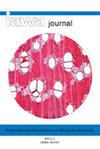Wood anatomy of 13 species from a successional tropical dry forest: description and ecological implications
IF 3.5
3区 农林科学
Q2 FORESTRY
引用次数: 3
Abstract
Successional tropical dry forest (TDF) species face water scarcity in the harsh dry season. Wood features provide insight into potential hydraulic stress coping mechanisms. Here, we describe the wood anatomy of 13 species occurring frequently in successional TDF. Given the marked rainfall seasonality of TDF, we expected these species to share conspicuous growth rings boundaries and drought-adapted anatomical features such as paratracheal parenchyma; although given the taxonomic and phenological diversity, a high wood diversity was also expected. Most species have diffuse-porosity. Axial parenchyma is diversely associated with vessels. Simple perforation plates are common and exclusive to all species. Different features poorly delimit growth boundaries, as previously observed in other tropical species. The main ground tissue is diverse, including nonseptate fibers, septate living fibers, or exclusively parenchyma. Axial and radial parenchyma may be scarce, abundant, or represent the main and unlignified ground tissue component. Vessel grouping ranges from solitary and 2–29 vessels per group. The mean vessel diameter range is ⩽50–200 μm; fiber walls are very thin to very thick. The anatomical features recorded among successional TDF species suggest different water stress coping mechanisms resulting from various anatomical combinations. Seven species exhibit wood features associated with drought tolerance (higher hydraulic redundancy, higher mechanical resistance, with vessel-ray connectivity likely given by banded parenchyma), whereas six species share xylem features associated with drought avoidance (taller and wider rays indicating higher water storage capacity). The complexity and multifunctionality of stem woody tissue should caution us against oversimplifying the relationship between anatomy, function, and ecological performance of TDF species.热带干林演替中13种木材解剖结构的描述及其生态学意义
演替热带干林(TDF)物种在严酷的旱季面临缺水。木材的特点提供了潜在的水力应力应对机制的洞察力。在此,我们描述了连续TDF中经常出现的13种木材的解剖结构。考虑到TDF明显的降雨季节性,我们预计这些物种具有明显的生长环边界和适应干旱的解剖特征,如气管旁薄壁;尽管考虑到分类学和物候多样性,但也预计木材多样性很高。大多数物种具有弥漫性孔隙。轴向薄壁组织不同地与血管相关。简单穿孔板是常见的,是所有物种所独有的。不同的特征很难划定生长边界,正如以前在其他热带物种中观察到的那样。主要的地面组织是多种多样的,包括不分开的纤维,分开的活纤维,或专门薄壁组织。轴向和径向薄壁组织可能稀少,丰富,或代表主要的和未木质化的地面组织成分。船只分组范围从单独船只到每组2-29艘船只。平均血管直径范围≤50 ~ 200 μm;纤维壁非常薄到非常厚。不同演替TDF物种的解剖特征表明,不同的解剖组合导致了不同的水分胁迫应对机制。7个物种表现出与耐旱性相关的木材特征(更高的水力冗余,更高的机械阻力,可能由带状组织提供的管射线连通性),而6个物种具有与避免干旱相关的木质部特征(更高和更宽的射线表明更高的储水能力)。茎木本组织的复杂性和多功能性提醒我们不要过度简化TDF物种的解剖、功能和生态性能之间的关系。
本文章由计算机程序翻译,如有差异,请以英文原文为准。
求助全文
约1分钟内获得全文
求助全文
来源期刊

IAWA Journal
农林科学-林学
CiteScore
3.40
自引率
15.80%
发文量
26
审稿时长
>36 weeks
期刊介绍:
The IAWA Journal is the only international periodical fully devoted to structure, function, identification and utilisation of wood and bark in trees, shrubs, lianas, palms, bamboo and herbs. Many papers are of a multidisciplinary nature, linking
 求助内容:
求助内容: 应助结果提醒方式:
应助结果提醒方式:


